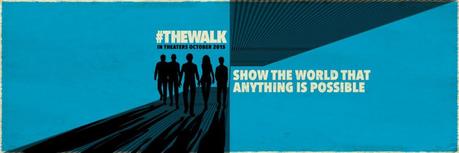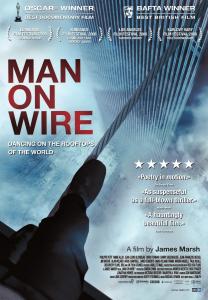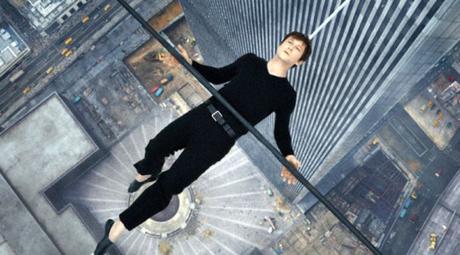There is a question which hangs over the entirety of Robert Zemeckis’ The Walk, and it’s not necessarily the most obvious one. In a story about a peculiar Frenchman who attempted to perform an illegal wire walk between the twin towers of the World Trade Center in 1974, you’d think the question would be whether or not he pulled it off. However, that’s actually never in doubt. We are pretty much told from the beginning that Philippe Petit (played here by Joseph Gordon-Levitt) did indeed walk across the towers. Instead, the real question is why he even wanted to take a leisurely stroll 1,350 feet above the ground in the first place
There is, frankly, no good answer. After Petit’s infamous walk, he was arrested by the New York City police and asked the obvious “why’d you do it?” question by the press. His response rejected the premise of the question, “There is no ‘why’. When I see a beautiful place to put my wire I cannot resist. I see three oranges and I have to juggle. I see two towers and I have to walk.”
These lines are repeated exactly by Gordon-Levitt near the end of The Walk. However, it is a viewpoint which is also stated from the outset since The Walk features Gordon-Levitt’s Petit standing atop a rooftop with a clearly cgi New York skyline behind him and talking directly to the camera to effectively narrate his own story. He defiantly tells us in the very first scene of the movie that asking him why he wanted to walk the towers is akin to asking Michelangelo or Da Vinci why they wanted to make their most famous paintings. Those paintings simply came out of them as per their artistic impulses, and the same is true for him.

Zemeckis certainly admires Petit as a showman and storyteller. The Walk arguably uses his story as a metaphor for the act of filmmaking. Petit functions as the ultra-determined director pursuing his vision with a singular focus, and his personality defects (e.g., extreme arrogance) are a direct result of that. His various collaborators, including those he brought with him from France and those he met in New York, function as the various members of a film production who gather around the director and do everything in their power to help him achieve his vision. In that reading of The Walk, the first half of the story is the “making of” portion, and the last half, i.e., the actual walk, is the big premiere. Petit’s narration is the director’s commentary.
Not that you have to delve that deeply into The Walk to enjoy it. However, when there is no concrete explanation for Petit’s actions beyond “he was compelled to do it” it’s hard not to look for a larger meaning. If you don’t, so much of the movie is completely undercut. The infectious, Oceans 11-esque heist portion where Petit and pals make their plans and set them into motion only for all of those plans to go off the rails can be consistently undone by naysaying thoughts like “But why are they doing all of this?” Petit at least sort of addresses that question by rejecting it. Almost all of his collaborators are given no motivation beyond “they thought Petit’s idea sounded really cool + it was the 70s.”
If you can get past all of that, and if you can give in to this film even though its ending is never in doubt, then The Walk is actually a rather enjoyable viewing experience. Despite his, um, let’s go with “adventurous” French accent, Gordon-Levitt’s showboating energy and agility carries you along, even as the film acknowledges that Petit and his occasional tempter tantrums could be a tad insufferable.
There are multiple charming sequences early on where we see Petit’s initial attempts at wire-walking and work with a circus, which is where we meet his mentor (Ben Kingsley). Petit’s sweet-natured courtship of a guitar-playing kindred spirit named Annie (Charlotte Le Bon) threatens to steal the movie as you find yourself wanting to see more of the two of them together and less of him recruiting of new collaborators (first a photographer, then a mathematician afraid of heights, then a….well, it keeps going like that). Once they all finally get to the towers and begin their “coup,” as Petit calls it, it plays like a masterclass in how to build tension in film.

If you’ve never seen Man on Wire before, when that scene pops up in The Walk it’s whimsical. If you have seen Man on Wire, though, that scene is a frustrating reminder that The Walk might not be making a compelling argument for why it actually needs to exist.

THE BOTTOM LINE
The real Philipp Petit later said of his walk, “To me, it’s really so simple: life should be lived on the edge. You have to exercise rebellion, to refuse to tape yourself to the rules, to refuse your own success, to refuse to repeat yourself, to see every day, every year, every idea as a true challenge. Then you will live your life on the tightrope.”
That particular spirit didn’t quite make it into The Walk. Despite the film’s obvious effort to function as a testament to the human need to create art, it sometimes feels close to “it was really cool that this one guy did this one thing that one time.” Thankfully, though, what he did was indeed pretty dang cool, and it translates to some truly arresting visuals, albeit ones which have been lessened in the transition from theaters to home video.
THE CRITICAL CONSENSUS
85% – “The Walk attempts a tricky balancing act between thrilling visuals and fact-based drama — and like its wire-walking protagonist, pulls it off with impressive élan.”
THE TRAILER

